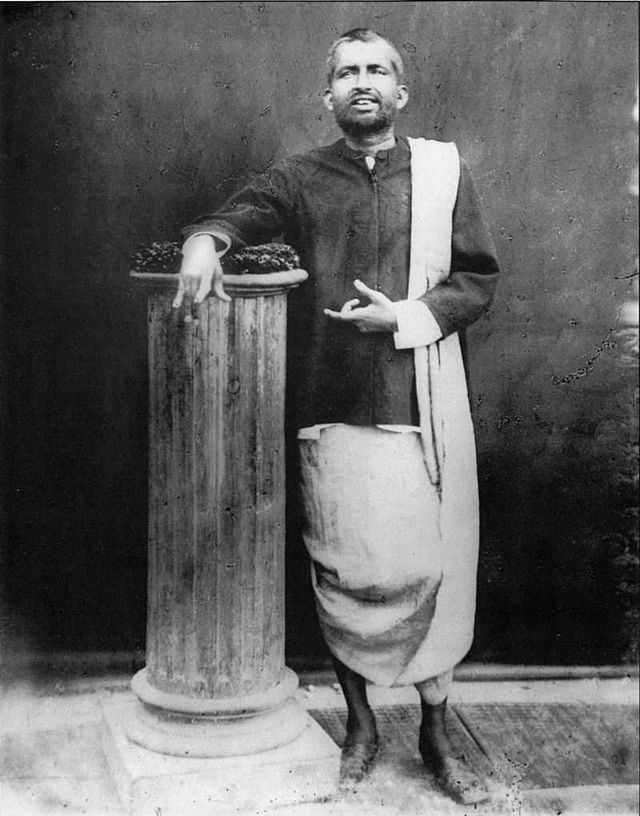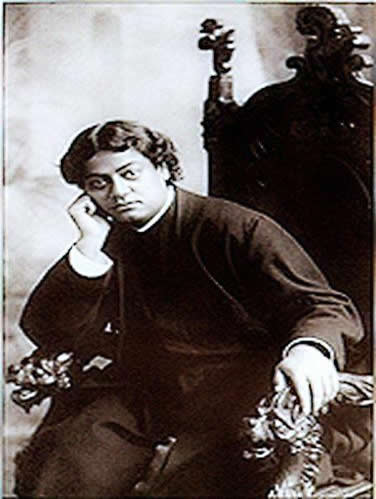Main changes in the XIX-XX sec :three aspects:
1)Neo Hinduism: modernity and inclusivism
From the 18th century onward India was being colonialized by the British. In contrast to the Muslim domination, this colonialization had a huge impact on Indian society, where social and religious leaders tried to assimilate western culture and modernize Hindus culture. During the 19th century, in response to western colonialism, Hinduism developed a large number of new religious movements , partly inspired by the European Romanticism, Enlightenment and also Christianity. which goes under the label Neo-Hinduism. Neo-Hinduism is term that have been used by modern scholars, primarily western, to characterize these interpretations which usually go along with instances of social reforms such as the abolition of caste system. Such ideas contributed to the Indian identity as a modern, tolerant and independent nation. Main figures of these movements are Ramakrishna and his disciple Vivekananda (see below).
2) Hindu Fundamentalism
As a counter effect of the opening towards the West exemplified by the Neo-Hinduism (see above), other movements stressed the unique and exclusivist character of Hinduvta (Hindus-ness), more in cultural and nationalistic terms, rather than merely religious ones. In fact, the nationalistic orientation of these groups and political parties is reflected in their names: for example, the Bharatiya Janata Party (BJP) means “the Party of the Indian People.” Similarly, the name of the Rashtriya Swayamesevak Sangh (RSS), a “self-defense” force associated with the BJP, means “National Volunteers Corps.”
Historically, RSS was founded in 1925 by Keshav Baliram Hedgewar (1889–1940), a physician living in the Maharashtra region of India, as part of the movement against British rule, later on, in 1951 the BJP was founded as its political wing.
Even if the BJP or the RSS do not advocate the Hinduvta in strictly religious terms, the main targets of their attacks ( political as well as physical) have traditionally been the religious minorities of Christians and – especially - Muslims. The principal concern of both groups is the danger posed to “the Hindus nation” by Islamic proselytism among lower-castes. Both groups have also vehemently opposed Christian proselytism in India for the same reason.
Consequently, in recent decades, communal tensions and religion-based politics have become more prominent. Religious violence in India has generally involved Hindus and Muslims, although incidents of violence have also involved Christians and Jews. Among the various examples, the 2002 riots in Gujarat are noteworthy as case of religious violence and Muslims' persecution (see below and source n° 2).
3) Hindus proselytism in the West
Traditionally, Hindus religious traditions has never been characterized by strong proselytizing tendencies. There have been cases of individual or collective conversion, but often related to political expansion's processes (es. the isle of Bali in Indonesia). Moreover, according to some Hindu views, only those born in India can have access to the teachings of Hinduism. This is the view also of contemporary Hindu Fundamentalism (see above).
In modern and contemporary times, however, the increasing globalization and theological innovations of Neo-Hinduism (see above) has brought a change. One of the most famous example of Hindus proselytism outside India is The International Society for Krishna Consciousness (ISKCON), known colloquially as the Hare Krishna movement (see below).
Analysis and contextualization of the sources:
Source n° 1
Portraits of Ramakrishna and Vivekananda
Ramakrishna is a Hindus religious leader, founder of the school of religious thought that became the Ramakrishna Order, and the best-known Hindu saint of the 19th century.
During his ascetic discipline, Ramakrishna commenced on a series of austere practices leading to the identification of the self with a deity in the various mystical traditions present in India, even including Islamic mysticism and Roman Catholicism. After each of these experiences, Ramakrishna claimed to have had the same experience of Brahman, the ultimate reality of the universe. Later in life he became famous for his pithy parables about the ultimate unity of the different religious traditions in this formless Brahman.
It is really important to note that the message that all religions lead to the same end was certainly a politically and religiously powerful one, particularly because it answered in classical Indian terms the challenges of British missionaries and colonial authorities who had for almost a century criticized Hinduism on social, religious, and ethical grounds. That all religions could be seen as different paths to the same divine source or, even better, that this divine source revealed itself in traditional Hindus categories was welcome and truly liberating news for Hindus.
His disciple and successor, who actually established the Ramakrishna Order, was Vivekananda, original name Narendranath Datta, (1863-1902) educated at a Western-style university where he was exposed to Western philosophy, Christianity, and science. He attempted to infuse vigor into Hindus thought presenting a modern and inclusivistic Hindu spirituality to the West. In fact, he appeared in Chicago as a spokesman for Hinduism at the World’s Parliament of Religion of 1893, where he stressed the intellectual, universal and humanistic side of the Vedas Corpus, the sacred texts of Hinduism, minimizing other ritual, magic and devotional components of Hinduism.
Vivekananda and the Ramakrishna Order thus played an important role in the spread of modernized Hindus ideas, in the West, particularly in the United States.
Source n°2
Understanding Gujarat Violence
Additional information:
Rama: is the seventh manifestation (Avatara) of the Hindus God Vishnu (see sec. 5) and a king of Ayodhya, an ancient city in Uttar Pradesh. Rama is also the hero of the Hindus epic Ramayana, which narrates his supremacy and victory over the Rakshasas, supernatural invaders of India, and the establishment of his reign characterized by wealth, peace and harmony. Rama thus symbolizes the glory of Hindus civilization. Therefore, even if the Hindu Fundamentalism addresses mainly to the national and cultural dimension, there is still a relationship with these religious-mythical figures and the violence occurred in Gujarat, triggered by chauvinistic zeal.
Source n°3
Russian Hare Krishna followers
Context:
The Hare Krishna movement is a Western and modern outgrowth of a popular Bengali devotional tradition, which began in the 16th century based on the worship of Krishna, a popular manifestation of Vishnu (see sec. 5), one of the supreme god in Hinduism. This organization is one of the most widespread modern Hindu traditions. It was founded in 1966 in New York City by A. C. Bhaktivedanta Swami Prabhupada (1896-1977). He received a European led education in the Scottish Church College and graduated in with majors in English, philosophy and economics. As many other modern Neo-Hinduism religious leaders (see above Ramakrishna) Bhaktivedanta Swami considered Moses, Jesus, and Mohamed to be empowered representatives of God, describing them within his writings as pioneers of the same essential message of dedication to God with love and devotion.
Analysis:
On the red flag there is written in Cyrillic the Mantra [A Mantra is a particular utterance in Sanskrit language, largely used in the context of Hindus religions, and it is typically conceived has having a peculiar power of its own.] that Hare Krishna believers chant aloud, often in public, in order to make proselytes. The Mantra is the following:
Hare Krishna Hare Krishna
Krishna Krishna Hare Hare
Hare Rama Hare Rama
Rama Rama Hare Hare
Basically the Mantra is formed by three vocative: Krishna, Rama (see above) and Hare, another name of Vishnu. The recitation of it is said to change one's own Karman and achieve liberation. Believers devote their lives to serving Krishna and spend several hours each day chanting the Hare Krishna Mantra. They are vegetarians, and renounce the use of alcohol and drugs. Male devotees often shave their heads leaving only a small tuft of hair as a sign of surrender to their teacher.
It is interesting to note the mixture of foreign cultural elements (Indian robes, shaved head, Indian drums) with indigenous ones ( accordion).
Interdisciplinary and intercultural information
(History)
Islam presence in India:
Islam is the second-largest religion in India, making up 13.4% of the country's population with about 177 million adherents and has a long story of interaction and conquests with India.
Islam first came to India with Arab traders as early as 7th century CE to the south cost of India. As it is widely known, there is much historical evidence to show that Arabs and Muslims interacted with India and Indians from the very early days of Islam, if not before the arrival of Islam in Arabia. Arab traders transmitted the numeral system developed by Indians to the Middle East and Europe.
Islam arrived in 11th century to coast of Gujarat in north west India. Muslim conquests in the Indian subcontinent mainly took place from the 12th to the 16th centuries. With the establishment of the Delhi Sultanate (1206), Islam spread across large parts of the subcontinent. Prior to the conquest of India by the British East India Company, the Muslim Moghul Empire (1526-1858) was able to annex or subjugate most of India's Hindus kings and has since become a part of India's religious and cultural heritage. One of the most famous Indian monuments in the world, the Taj Mahal (UNESCO World Heritage) was built under the Moghul Empire and it is one of the finest pieces of Muslim architecture.
Answer to question n° 2:
The answer is obviously Mohandas Karamchand Gandhi (1869 – 1948). The "Father of India" is said to be strongly influenced by the writings of
Vivekananda (see above).








